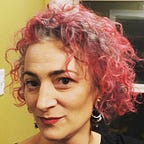All In
It’s a heavy thing, knowing your life will be abbreviated. Cut short due to a rare, genetic defect. Clearly, none can truly know when their body will yield to outside forces, but possibility and probability aren’t the same thing. Forces greater than entropy bear on me. Destructive forces that flow through the very marrow of my bones.
The impact of these forces has been vast. Profound loss, death and decay, that stripped me of parent, identity and ability. The ripples of dysfunction that ebb through my body began with a tiny change, a slight disturbance in the coding on a gene involved with maintaining the integrity of my chromosomes and the cells they direct.
Passed to me by my father Linus, my family’s particular mutation doesn’t start causing serious trouble as early as in most families with the very same mutation. Most individuals with mutations in the Tinf2 gene, which helps protect the last bits of genetic code on chromosomes known as telomeres, begin experiencing life-threatening symptoms as very young children. Few survive to their mid-20s, which was my age when the edges of my genetic fabric began seriously fraying.
Every person has telomeres, which, similar to the plastic caps holding ends of shoelaces together, bind together strings of genetic code known as chromosomes. Telomeres, as well as chromosomes and all other genetic components of a cell, are copied each time a cell replicates. Each replication, however, results in miniscule bits of the telomeric code being left behind. As a result, telomeres shorten with each cell division. When the telomere is gone — akin in to what happens when shoelace tips become worn away — the genetic string it’s binding falls apart. This process is the reason skin loses elasticity, the elderly develop anemia, and cancer risk increases with age.
My telomeres, compared with others, were extremely short when I was born. Their destabilization occurred before I showed symptoms and affects every cell in my body. There is bone marrow failure, skin fragility, fingernail splitting and hair loss. Epithelial tissues, like skin and linings inside the mouth and throat, become thick and often cancerous. Tear ducts close. Lung and liver tissues become scarred. Joints fail. The illness affects every single tissue, diffused throughout the body.
Individuals with genetic defects like mine, one of more than fourteen known mutations that cause diseases known collectively as telomere biology disorders, do not ripen into old age. There aren’t centenarians among us. We flame brightly and burn out fast, accelerated by volatile genetic coding and an instinctive race against time. I can still hear echoes of my stepdad Roger’s voice chiding me, ‘Stop living at 100,000 mph!’, to which I’d smartly retort, ‘I can sleep when I’m dead!’ As a reckless and blissfully unaware teenager I was oblivious as to how quickly I was careening toward eternal slumber.
There is no blueprint for the trajectory of my illness, nor is there a cure. Unlike some diseases which have defined symptoms and large cohorts of patients on which to draw data, my telomere disorder, known specifically as dyskeratosis congenita, or DC, is rare and complex. With an occurrence rate of less than one in one million, patients truly are unique. Amplifying this uniqueness is that among the few hundred thousand individuals on the planet affected by telomere biology disorders, no two have the same disease manifestation. Even in the same family symptoms vary wildly from person to person. A family could have a 15-year-old child with no outward expression but a younger brother with both bone marrow failure and pulmonary issues.
That affected members of my family, including myself, my father, two brothers, one uncle and three cousins, were not faced with a magnitude of problems until later in life, that our early years weren’t marked by needles and hospitals, perhaps makes us lucky. If so, it’s a strange luck.
Is there providence in carrying the genetic legacy that claimed your father when he was only 43? Or blessing in understanding that you will probably die before your unaffected sister and brother, and that your mother, who was there at the beginning, will likely also be there at the ending? It is damn heavy. And only I can bear it. At times, it’s been too much. Times when the disease burden on my body nearly killed me. Moments when the horror of regarding my future forced me to question its worth. I wouldn’t wish it on anyone.
But I can’t begrudge it. The struggles of my past, the weight of my ever present death, these encumbrances have shaped me. They’ve strengthened me, empowered me, given me definition and purpose. My survival instinct amplified by an indefatigable desire to overcome oppressive DNA. My life cannot be marked by passivity. There have been choices, mistakes and consequences, but no time for regret. There is laughter, there is happiness, and there is love. There is hope, there is always hope. What’s possible is not the same as what’s probable.
In this life, I’m all in. There’s no sitting back, waiting for the inevitable. There is no neutral, only forward and in high gear. And when my body can no longer hold up against the unraveling of my DNA, when I’ve exhausted my physiologic energy and I finally put down this burden, the goodness and light I’ve fostered in my life will endure.
